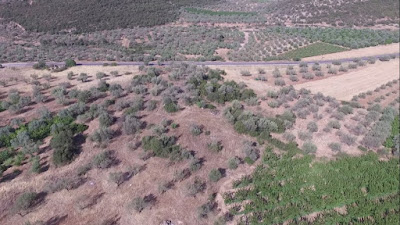One of the interesting results of this year was the very low artifact densities. In 2014 we counted over 10,000 tiles and sherds per square kilometer surveyed; in 2015 that number was about 6,500, and in 2016, it was just above 2,700. In some ways, this wasn’t too surprising; a relatively large amount of our territory this year was taken up by long, high ridges oriented east-west that back up against the mountain range that separates the Inachos and Xerias river valleys. The ridges themselves were too rocky and removed from arable land to have sustained settlements in most periods. Rather, our sites this year tended to be located on small hills immediately above the course of the Inachos river, especially at “pinch points” where the valley narrows. On the east side of our survey area, this type of site was represented by Kastraki, where the ruins of a Classical farmstead, with the remains of its stone tower and a large millstone, were surrounded by a fairly dense scatter of sherds and tiles, including Late Roman material.
Many of our high density fields from the first two seasons were especially associated with Classical and early Hellenistic materials. Our 2014 season included the polis of ancient Orneai, which seems to have reached its maximum extent and intensity in these periods, and our 2015 season included a large settlement near Schinochori, probably a town associated with the Argive polity. In the 2016 season, however, only a scattering of Classical and Hellenistic artifacts were found on the left bank of the Inachos river. Thus, it may be that we have evidence for a boundary between the communities of the plain (surveyed in 2015) and those of the upper valleys (surveyed in 2014), manifesting itself as a largely empty space or borderland. This was not true in all periods, however: we found fairly consistent traces of Medieval and early Modern material in the 2016 season, especially on the slopes and hills above the river and its tributaries.In non-archaeological developments, we continued our little traditions of Saturday fieldtrips to sites in the area, of going to see a play at Epidavros (this time, a raucously hilarious performance of Aristophanes’ Ploutos) and of adopting a local stray puppy and taking it back to North America.
For more information on WARP, please visit our project website and blog at westernargolid.org!
Dimitri Nakassis
WARP co-director






No comments:
Post a Comment